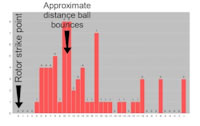You may think roulette computers are always sophisticated pieces of hardware. In actual fact, most are very simplistic, although people that sell them want to you believe it is space-age technology. Here I will explain the simplest possible roulette computer algorithm, and it is used by almost every roulette computer.
Understanding What Makes Roulette Beatable
First we’ll need to identify various parts of the wheel so you know what I’m talking about:
Ball track: where the ball rolls
Rotor: the spinning part of the wheel where the numbers are
Pockets: where the ball comes to rest
Clocking: simply another word for “take timings of”. ie if you “clock” the rotor or ball, you are simply clicking buttons to take timings of revolutions.
What happens during a spin:
When the ball is released, it gradually slows down, loses momentum and falls from the ball track. Sometimes the ball hits a metal deflector (diamond) and falls without much bounce. Sometimes it bounces everywhere. Sometimes there is still a fair bit of ball bounce. And while you can never predict exactly where the ball will fall, YOU DONT NEED TO. You need only to predict roughly where the ball will fall with enough accuracy to overcome the casino’s slight edge against you (house edge). For some wheels, this is very easily done. For other wheels, it is much more difficult.
Here are some of the principles that are typically used to predict where the ball will land with professional roulette prediction techniques:
Dominant Diamonds
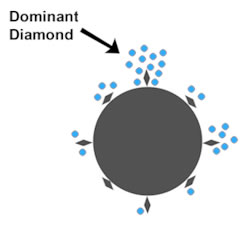
On most wheels, the ball will tend to hit a specific diamond more frequently than others. You can check this for yourself at your local casino by creating a chart like the one shown left. At the very least, you will find there are some diamonds that the ball almost never hits, or perhaps some areas where the ball almost never falls from the ball track. This is not random, and inevitably leads to more predictable spin results.
Now that we know WHERE the ball will fall at least an inordinate amount of times, what if we knew what number was under this area WHEN the ball fell? This is easy to determine, and I’ll explain how later.
Consistent Ball Timings
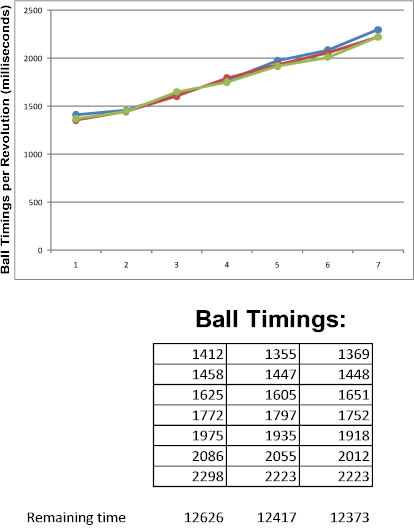
You may think that when the ball is released, the timings of each revolution is random. The reality is especially the last few ball revolutions of the ball occur with much the same ball timings. The right chart shows the revolution timings for the last few revolutions of the ball on three different spins. You can see they are all very similar. The very bottom row shows the sum of all timings from these last seven ball revolutions. The greatest deviation in timings is no less than 300ms (0.3 seconds).
This means that if we knew when the ball timing (speed) was about 1350ms per revolution (about 1.3s per revolution), then we’d know the ball has about 12,500ms (12.5s) before it likely hits the dominant diamond and falls. Again of course this wont happen every time. It only needs to happen enough of the time.
Do you need to know the precise ball speed to know when there are 7 ball revolutions remaining? NO, you can virtually guess when there are roughly 7 revolutions remaining. Do you need to know exactly how many milliseconds are remaining? NO, because the ball revolution timings for the last few revolutions are much the same. This means finding which number will be under the diamond when the ball hits it is very easy to determine. This is a critical to understand.
Ball Scatter
Ball scatter is basically ball bounce. Sometimes the ball will miss all diamonds. Sometimes it hits a different diamond to usual. But a lot of the time, the ball will hit the dominant diamond, then bounce roughly 9 pockets along before coming to rest. There is a lot more to it in reality, but from a simplistic perspective, this is scatter.
If you check your local casino’s wheels and compare where the ball first touches the rotor to its final restring place, you will see the ball bounce is usually still quite predictable over 15-30 or so spins. How we apply this knowledge is explained later.
Visual Ballistics
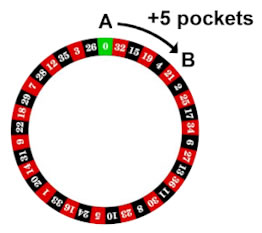
So far we know that on many wheels, the ball will mostly fall in the same region (dominant diamond), then mostly bounce 9 or so pockets. On many wheels we can actually skip the step where we consider how far the ball bounces after it hits the dominant diamond. This is because there is a more direct approach as explained below:
If you had a method to determine when the ball is about 1300ms (1.3s) per revolution, at that precise moment, you could look at the number under the reference diamond and write it down. Then wait for the ball to fall and come to rest. This will leave you with a first and second number like “A,B”. For example say you got 0,21. This will tell you that the ball landed 5 pockets clockwise of your initial “reference” number. See the left image for reference.
This tells us that starting from our REFERENCE NUMBER (A), the ball has about 12.5 seconds left before it hits the dominant diamond and bounces about 9 pockets, and ends up about +5 pockets from the reference number. Where the ball comes to rest is the WINNING NUMBER (B).
You may need to read this a few times, but the concept is very simple. Also see the video below which explains the concept too.
What I’ve explained above is a very simple method of beating roulette, or more like the science behind a method called “visual ballistics”. The key component of any visual ballistics method is how you determine when the ball is at the targeted speed. Because when you have identified that target speed, you will know the ball has the same ball revolutions left before it falls and bounces however many pockets.
Can you virtually GUESS when the ball has 1 revolution remaining? How about 2 or 3 revolutions remaining? How about 5 or 6? It really is not at all difficult. If you can be accurate to within 1 ball revolution, then you can achieve exactly the same accuracy as most roulette computers without needing any device. Remember, you don’t need to measure accuracy to within 5ms, 20ms or even 100ms because you are only determining how ball ball revolutions are remaining, and this automatically tells you the remaining ball travel time. You can be very sloppy and still be correct most of the time. And that’s as accurate as you need to be to equal the accuracy as most roulette computers.
In a follow-up video I’ll release soon, I’ll teach you a method that can accurately tell you how many ball revolutions are remaining. And you will achieve the same accuracy as almost every roulette computer.
The Basic Roulette Computer Algorithm
This is what most roulette computer sellers don’t want you to know. If you understand all of the above, you’d see how incredibly simple it all is. You’d also understand how you can afford to be very sloppy, and can just about guess how many revolutions are remaining and you’ll still very accurately determine how many milliseconds are left before the ball falls. It is essential to note that ALL roulette computers use the above principles. You can look at the demonstration videos of basic roulette computers, and use basic visual ballistics to achieve almost exactly the same accuracy – without even using any electronic device. But because sellers want to make their products seem more competitive and exclusive, they’ll tell you their devices are highly sophisticated with unparalleled accuracy.
Essentially the differences between the basic visual ballistic method I’ve explained and a simplistic computer are explained in the below chart:
Visual ballistics vs a Basic Roulette Computer
The main difference between typical visual ballistics and a basic roulette computer is that roulette computers are EASIER to use. There is no difference in accuracy between a skilled visual ballistic and computer player. Why? Because they both do exactly the same thing. They both just estimate when there are 7 or so ball revolutions remaining. They both “tune” by looking at how far the actual winning number is from the reference number, then making a simple adjustment.
How a basic roulette computer works (almost identical to visual ballistics)
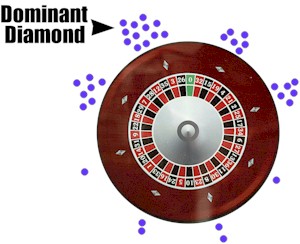
First the player finds a wheel where the ball mostly hits a particular diamond. Most wheels are like this. There are a few other basic procedures to evaluate a wheel, but this is just a simplified example. The player can create a small diagram l.ike the one shown left.
To use the computer, the player waits for the ball to be released then clicks a hidden button each time the ball passes a particular reference point (such as a diamond / metal deflector). This determines the timing of ball revolutions.

The player keeps clicking the hidden button until the time interval between clicks passes a certain threshold – this is when the ball is at a specific speed. When this threshold is passsed, the computer will vibrate at which time the player notes which number is under the reference diamond. Let’s say it was number 32 (number A). This is an un-tuned prediction so we call it the RAW prediction. Then the player waits for the ball to fall and come to rest in a pocket. Let’s say the winning number is 6 (number B). If we look at the distance between each number (A and B) in the chart left, we see this is +9 pockets (9 pockets clockwise) from the first to the second number.
It is important to understand that when the computer vibrates, this is telling the player that the ball has reached a target speed. And from this point, even on different spins, the ball will complete mostly the same number of revolutions before it likely hits the dominant diamond then falls.
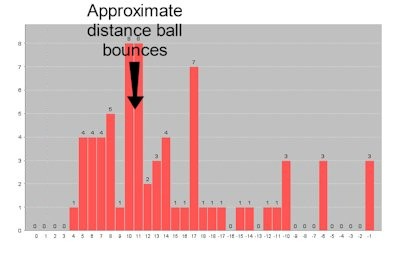
The player repeat this process for 30-60 spins and add each jump value to a chart like the one shown left. After enough spins, we will find that certain areas of this chart have groupings of high bars (called ‘peaks’).
In the chart shown left, the peak is at about +10 pockets. This means for the player to win, they need to place bets around +10 pockets from the “raw prediction” (Number ‘A’).
To simplify:
The player just keeps clicking a button until the interval between clicks is the say greater than 1,000ms (1 second). When this happens, the computer vibrates to inform the player the target ball speed is reached. From that point, the ball will mostly complete 5 or so revolutions before it hits the dominant diamond then bounces much the same distance.
To know where to bet each spin, the player notes the number under the reference diamond when the vibration is felt, then compares how far the ball actually lands from this original number. Then to know where to bet, the player just makes the adjustment on each spin.
Sounds simple enough? Almost every roulette computer you will find for sale will do only the very basics as explained above. It was all you needed 50 years ago, but beating modern wheels in modern casinos is far more complex.
Common Visual Ballistics Deception
Some sellers of visual ballistic methods will charge you thousands of dollars to learn visual ballistics methods you have learned here for free. Before you paid them, they would have told you that the method they teach is the best. But the truth is visual ballistic methods are all very similar. They all use exactly the same principles. Certainly some visual ballistic methods are overall better than others, but the differences are not often significant. One exception is if the method relies on a consistent rotor speed for accuracy to be achieved. For example, one individual claims his visual ballistics method is best because it enables you to obtain a visual ballistics prediction when the ball is at any speed. This may sound great, and he lures in uninformed people. But the reality is the method relies on the player having an unrealistic top-view of the wheel, god-like skill, and a rotor speed that is almost identical on all spins. The reality is such a methods cannot be applied in real casino conditions. Even slight variations in rotor speeds alone eliminate accuracy. On the other hand, one of his competitors who he unjustly attacks teaches a far better method that doesn’t require consistent rotor speeds. So you need to be very careful about who you believe, or rather understand the principles for yourself, so you understand what is feasible.
NASA’s roulette computer, or snake oil?
Roulette computers that you can buy typically range from $500 – $5000, yet most do exactly the same thing. How is the price difference justified? IT ISN’T. Don’t just take my word for it. So you know this for yourself, try using visual ballistics on their demonstration videos, and you’ll achieve the same accuracy without even using a roulette computer. Remember that no matter what a vendor tells you, you can easily expose nonsense with careful testing and research of your own. If you prefer to just take other people’s word for it, don’t expect to know the truth.
Of course every merchant is expected to promote their product, and it is common for merchants to stretch the truth about their products. However, the gambling industry has far more deception and false advertising in it than any other area of business I’ve ever known. It seems every roulette computer seller wants you to believe their device is space-age technology that cannot be obtained anywhere else. But the reality is almost every roulette computer uses the same basic algorithm explained on this page, and the accuracy differences between them are virtually negligible. Don’t let technical talk and fancy charts fool you. When you break it all down, you are left with a salesman trying to sell a basic computer that is no better than visual ballistics.
The simplest roulette computer I offer is called the “Basic roulette computer”. No fancy names. It is just a basic roulette computer using the basic design described above. It is FREE to my roulette system players because it realistically can beat only perhaps 5% of wheels, and still the accuracy is nowhere what could be achieved. Other device sellers sell comparable devices with exactly the same accuracy for between $500 – $5,000. Again, the price differences are not justified. I distribute this device for FREE. You can achieve exactly the same accuracy with basic visual ballistics methods. Alternatively you could buy a device for $2000 that does exactly the same thing, except the vendor blatantly lies and claims it does much more, and is the most accurate device available anywhere.
The various roulette computers I offer are compared to devices from other vendors at the roulette computer comparison page. There you can better understand the difference between a simplistic device that can only beat easily beaten wheels, and a device that squeezes every last bit of predictability from a roulette wheel while making application practical, covert and easy.
NEXT PAGE > Ball deceleration rate changes
To get the best free roulette systems that really work, see the top 5 proven roulette systems and the video series below. It's the best 100% free information for winning roulette you'll find. It's written by professionals who are really earning a living from roulette. |

